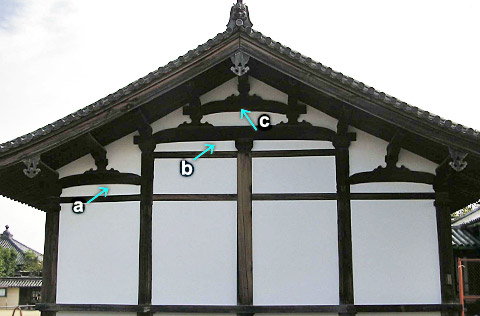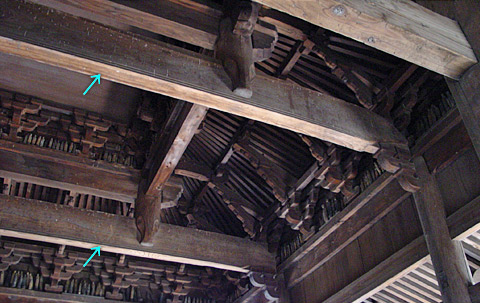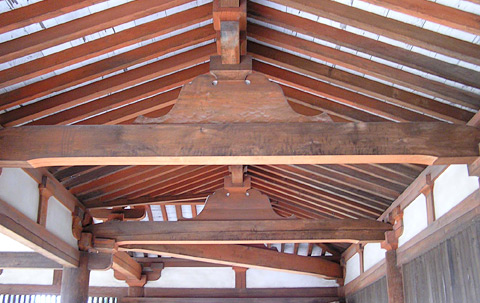|
||
 |
||
1 Uchimuro kouryou 内室虹梁 are rainbow beams installed on the underside of an open roof *keshou yaneura 化粧屋根裏, when a ceiling is not installed.
2 Uchikouryou 内虹梁 are used on the underside of a roof in buildings that have no ceilings.
3 Sotokouryou 外虹梁 are placed on the outerside of a structure.
4 Tsumakouryou 妻虹梁 are rainbow beams used and exposed within the gable pediment of a gable roof *kirizuma yane 切妻屋根 or a hip-and-gable roof *irimoya yane 入母屋屋根.
5 *Mizuhiki kouryou 水引虹梁 is a rainbow beam which spans the distance between the outer pillars of a step canopy *kouhai 向拝 in a shrine or temple.
6 *Tsunagikouryou 繋虹梁 are rainbow beams placed between the outer pillars of the aisles *hisashi 廂 and the pillars surrounding the core of the building *moya 母屋 or between the pent roof addition beyond the hisashi *mokoshi 裳階 and the moya pillars. They also connect the outer pillars of the step-canopy and the body of the building where they are attached above the head tie beams *kashiranuki 頭貫.
7 *Ebikouryou 海老虹梁, also written 蝦虹梁. Lit. a lobster or shrimp shaped rainbow beam. It is so-named because of the shape of its curve. It came into use in the hisashi of Zen style buildings or in hisashi influenced by the Zen style. At first, only the upperside was given a hump while the ends of the curved underside were inserted into the hisashi and moya pillars at the same height. Later, the beam was given such an exaggerated curve that the end inserted into the moya pillar was at a higher level than the end inserted into the hisashi pillar.

sotokouryou 外虹梁, tsumakouryou 妻虹梁
a) *tsunagikouryou 繋虹梁 b) daikouryou 大虹梁 c) nijuukouryou 二重虹梁
Houryuuji Denpoudou 法隆寺伝法堂 (Nara)
a) *tsunagikouryou 繋虹梁 b) daikouryou 大虹梁 c) nijuukouryou 二重虹梁
Houryuuji Denpoudou 法隆寺伝法堂 (Nara)

uchimuro kouryou 内室虹梁
Shoufukuji Jizoudou 正福寺地蔵堂 (Tokyo)
Shoufukuji Jizoudou 正福寺地蔵堂 (Tokyo)

uchikouryou 内虹梁
Houryuuji Kairou 法隆寺回廊 (Kyoto)
Houryuuji Kairou 法隆寺回廊 (Kyoto)
(C)2001 Japanese Architecture and Art Net Users System. No reproduction or republication without written permission.
掲載のテキスト・写真・イラストなど、全てのコンテンツの無断複製・転載を禁じます。

